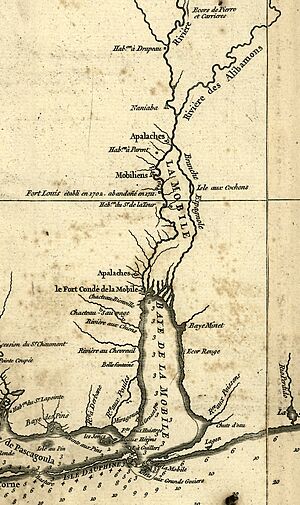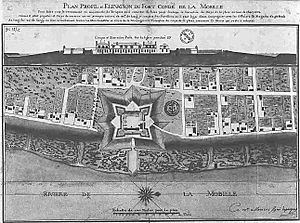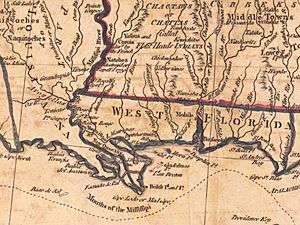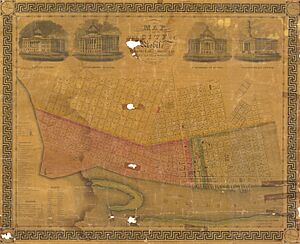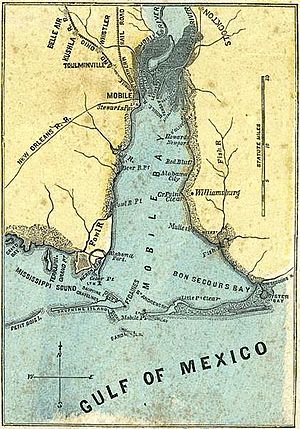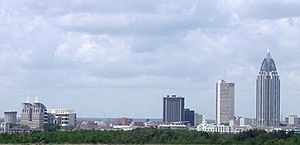History of Mobile, Alabama facts for kids
Mobile, Alabama, has a long and interesting history, starting as a French colony and later becoming part of the United States. It was founded in 1702 as the capital of French Louisiana and stayed French for over 60 years. In 1720, during a war between France and Spain, the capital moved to Biloxi because Mobile was too close to the fighting.
In 1763, Great Britain took control of Mobile after winning the Seven Years' War. Later, during the American Revolutionary War, Spain captured Mobile. Spain kept the city after the war ended in 1783.
Mobile became part of the United States in 1813. American forces captured it and added it to the Mississippi Territory. It then became part of the Alabama Territory in 1817. Finally, on December 14, 1819, Mobile joined the new state of Alabama. Forty-one years later, in 1861, Alabama left the United States and joined the Confederate States of America. It rejoined the United States in 1865 after the American Civil War. Mobile had been French, British, Spanish, and American over 160 years before the Civil War.
Contents
Early Explorers: 1500s
Spanish explorers sailed into the Mobile Bay area as early as 1500. They called the bay Bahía del Espíritu Santo, which means "Bay of the Holy Spirit." Alonso Álvarez de Pineda explored the area more in 1519.
In 1528, Pánfilo de Narváez traveled through what was likely the Mobile Bay area. He met Native Americans who ran away and burned their towns when his group approached. This happened again when Hernando de Soto explored the area more than eleven years later.
Hernando de Soto explored the Mobile Bay area in 1540. He found that Muscogee Native American people lived there. During his trip, his forces destroyed a fortified town called Mauvila or Maubila. The name Mobile later came from this town. A big battle with Chief Tuscaloosa and his warriors happened somewhere north of where Mobile is today.
The next large expedition was led by Tristán de Luna y Arellano in 1559-1561. He tried to start a permanent Spanish colony nearby in Pensacola, Florida, but it was not successful.
Colonial Times
French Rule: 1702 to 1763
Even though Spain had been in the area sometimes, the French started a settlement on the Mobile River in 1702. Pierre Le Moyne d'Iberville, from his base at Fort Maurepas, directed his brother, Jean-Baptiste Le Moyne, Sieur de Bienville, to establish it. The settlement was called Fort Louis de la Louisiane and was the first capital of the French colony of Louisiana.
Mobile's first Roman Catholic church was started on July 20, 1703. In 1704, 23 women, known as "casquette girls," arrived on a ship called the Pélican. The ship also brought yellow fever from Havana. Many colonists and Native Americans died from the illness. The first African people brought to the colony as slaves also arrived on a French supply ship. The number of people in the colony changed a lot, growing to 279 by 1708 but dropping to 178 two years later because of disease.
More diseases and floods caused Bienville to move the town several miles downriver in 1711 to where it is now. A new Fort Louis was built at the new location. The colony was losing money, so in 1712, Antoine Crozat took over running it for 15 years. The colony had 400 people. In 1713, Antoine Laumet de La Mothe, sieur de Cadillac, who founded Detroit, became the new governor. He was recalled to France in 1716 due to problems. Bienville became governor again for a short time.
In 1717, John Law and his Company of the Indies took over the colony. Bienville became governor of Louisiana once more. In 1719, France was at war with Spain, and Mobile was on the battlefront. So, Bienville decided to move the capital to Old Biloxi, further west.
The capital of Louisiana moved to Biloxi, Mississippi, in 1720. Mobile then became a military and trading outpost. In 1723, a new brick fort with a stone foundation was built and named Fort Condé. Mobile remained a major trade center with Native Americans during the French period. This led to the widespread use of Mobilian Jargon, a simple trade language, from Florida to Texas.
British Rule: 1763 to 1780
Mobile became part of the British colony of West Florida in 1763. This happened after the Treaty of Paris was signed, ending the French and Indian War. Under British rule, the colony grew. The British renamed Fort Condé to Fort Charlotte, after the English Queen. They also improved the port. Important goods exported included timber, indigo, animal hides, and rice.
Spanish Rule: 1780 to 1812
Spain captured Mobile during the American Revolutionary War in 1780. They kept Mobile after the war ended in 1783. Mobile was then part of Spanish West Florida for over 30 years. It was controlled from Pensacola, Florida, until American forces captured it in 1813.
Republic of West Florida
The United States and Spain had long talks about West Florida. American settlers moved into the area and did not like Spanish control. British settlers who stayed also disliked Spanish rule. This led to a rebellion in 1810. On September 23, 1810, rebels took over the Spanish fort in Baton Rouge, Louisiana. They raised the flag of a new republic, the Bonnie Blue Flag. This "Republic of West Florida" lasted for three months. It claimed land south of the 31st parallel, west of the Perdido River, and east of the Mississippi River. Spain still controlled the town of Mobile itself.
Becoming Part of the U.S.
Mississippi Territory: 1813 to 1817
Before the War of 1812, the Spanish in Mobile allowed British merchants to sell weapons to Native Americans. This was to bother Americans who were settling in Alabama. During the war, General James Wilkinson led American troops from New Orleans to capture Mobile. The Spanish gave up in April 1813. The American flag was raised over Mobile for the first time, and it became part of the Mississippi Territory.
In September 1814, British forces tried to take Fort Bowyer on Mobile Bay, but American forces stopped them.
Alabama Territory: 1817 to 1819
In March 1817, the U.S. state of Mississippi was formed. This split the Mississippi Territory in half. For the next two years, Mobile was part of the new Alabama Territory. In 1819, after two years as a territory, Alabama became a full American state.
After Statehood
Growth and Change: 1820 to 1860
In the early 1800s, the cotton industry grew rapidly. This brought a huge increase in trade to Mobile, which had been a quiet frontier town. For almost 50 years, Mobile was a very busy international seaport, second only to New Orleans on the Gulf Coast. Its success came from cotton, which was shipped downriver by flatboat or steamboat from farms in Mississippi and Alabama.
Fires caused damage to the city. In October 1827, a fire destroyed most of the old city. Another fire in 1839 burned part of the city. Despite these problems, Mobile was one of the four busiest ports in the U.S. by the 1850s. The money from trade made the city a cultural center. Mobile became well-known across the country and the world.
During this time, Mobile became a diocese of the Roman Catholic Church. Spring Hill College, one of the oldest Catholic schools in the country, was founded in 1830.
In 1860, the Clotilde, the last known ship to bring enslaved people to the Americas, was left by its captain near Mobile. After the American Civil War, some of these people formed their own community called Africatown near the Mobile River. They kept their African customs and language for many years.
Civil War: 1861 to 1865
Mobile grew a lot before the Civil War. The Confederates built strong defenses around it. Union naval forces, led by Admiral David Farragut, set up a blockade to stop ships from entering or leaving Mobile. The Confederates built fast, low ships called blockade-runners to try to get past the Union ships. The Hunley, the first submarine to sink an enemy ship in battle, was also built and tested in Mobile.
In August 1864, Farragut's ships fought their way past Fort Gaines and Fort Morgan, which guarded the mouth of Mobile Bay. They defeated Confederate gunboats and the ironclad CSS Tennessee in the famous Battle of Mobile Bay. It is said that Farragut famously said, "Damn the torpedoes, full speed ahead," after a Union ship, the USS Tecumseh, hit a Confederate mine and sank. The Tecumseh is still in Mobile Bay today. The city of Mobile later surrendered to the Union army to avoid being destroyed.
Sadly, on May 25, 1865, weeks after the Confederacy had ended, an explosion at an ammunition depot killed about 300 people and destroyed a large part of the city.
After the War: 1866 to 1899
After the war, Mobile faced challenges. The city's government and economy were careful, which limited its growth for many years. The late 1800s were a difficult time for Mobile. The city faced financial problems and was deeply in debt by 1875. This debt had been growing since the 1830s.
In 1879, the state government changed Mobile's city charter. The "City of Mobile" was ended, and three city commissioners were appointed to run the new "Port of Mobile." Their job was to reduce the city's debt. The debt problem was finally solved in 1906.
Modern Times
Early 1900s: 1900 to 1949
At the start of the 1900s, Mobile's population grew from about 40,000 in 1900 to 60,000 by 1920. The city received money from the government to improve its harbor, making the shipping channels deeper. During and after World War I, manufacturing became very important to Mobile's economy, especially shipbuilding and steel production.
In 1902, the city government passed its first segregation law, which separated people by race on city streetcars. Mobile's African American population protested with a two-month boycott, but it was not successful. After this, more laws were passed to separate people by race.
World War II led to a huge increase in Mobile's population. Many workers moved to Mobile to work in shipyards and at Brookley Army Air Field. Between 1940 and 1943, over 89,000 people moved to Mobile for war industries. Mobile was one of the cities that built "Liberty ships" to help the war effort. These ships were built faster than enemy countries could sink them. Gulf Shipbuilding Corporation built freighters, destroyers, and minesweepers. The U.S. Army bought the city airport and developed Brookley Army Air Field, which became Brookley Air Force Base. Brookley quickly became the largest employer in the area. In the mid-1960s, the Air Force Base closed, and the airport returned to the city. Today, it is an aerospace and industrial site called the Brookley Aeroplex.
During the war, the large number of workers caused a big housing shortage. People rented out extra rooms, porches, garages, and even chicken coops. Several government housing projects were quickly built for the new workers. Some of these still exist, like the community of Birdville.
Late 1900s: 1950 to 1999
By 1956, Mobile's size had tripled to support its growth. The closing of Brookley Air Force Base in the mid-1960s caused economic problems that took many years to overcome. Also, after the war, the paper industry became a major industry in Mobile.
Legal racial segregation ended with the Civil Rights Act of 1964. Mobile had been more open to racial integration than some other Southern cities. The police force and a local college were integrated in the 1950s. Buses and lunch counters were voluntarily desegregated by 1963. However, schools and many other places remained segregated. In 1963, three African-American students sued the Mobile County School Board because they were not allowed into Murphy High School. A federal court ordered them to be admitted for the 1964 school year. In 1964, the University of South Alabama opened as an integrated college.
Mobile's city government changed in 1985. Instead of three city commissioners elected city-wide, it changed to a mayor and a city council with seven members elected from different districts. This change happened after African-American residents challenged the old system in court.
Hurricane Frederic hit Mobile on September 12, 1979, causing a lot of damage. Many residents were without power, water, and phones for weeks. However, only one death was reported. Money for recovery after Frederic helped the economy grow in the 1980s.
In the late 1980s, the city council and Mayor Mike Dow started a plan called the "String of Pearls Initiative." They wanted to make Mobile a modern, competitive city. Many new buildings and projects were built. The government also encouraged the repair of hundreds of old buildings and homes downtown.
Shipbuilding started to return to Mobile with the founding of Austal USA in 1999.
2000s to Today
Mobile had some damage from Hurricane Ivan in September 2004. It was damaged again by Hurricane Katrina in August 2005. A storm surge caused flooding in eastern Mobile and downtown. In September 2005, Mobilians elected their first African American mayor, Sam Jones.
Another important building was added to Mobile's skyline in 2007: the RSA Battle House Tower, the tallest skyscraper in Alabama. In January 2008, the city hired a design firm to create a new plan for the downtown area and nearby neighborhoods.
Images for kids


